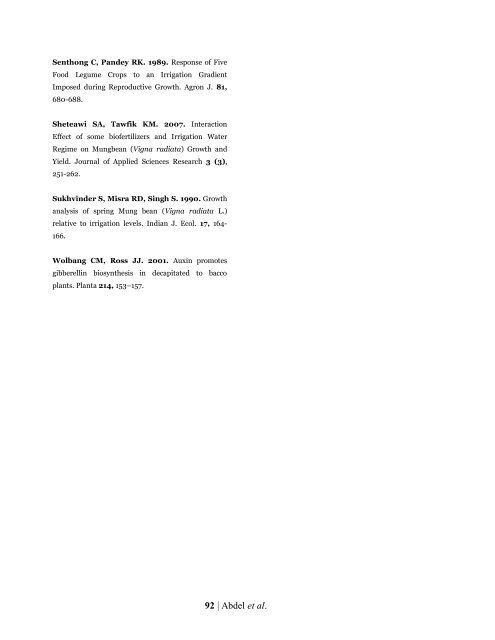Response of mungbean (Vigna radiata L., Wilczek) to gibberellic acid (GA3) rates and varying irrigation frequencies
Abstract An attempt was made to investigate the response of mungbean local cultivar to irrigation frequencies and for improving its drought resistance capability by the application of 0, 100 and 200mg/l GA3. Results showed that irrigating mungbean plants every 8 days drastically reduced plant height (46.8%), internodes length (32.1%), number leaves per plant (64.3%), leaf area per plant 9158.5%), leaf area index (179.3%), inflorescence number per plant (119%) pod length (22.6%), pod number per plant (117%), seed number per pod (23.8), biomass yield (74.6%), yield (91.3%) and seed yield per plant (83.7%). However, this treatment highly increased number first fruiting node (180.1%) and weight of 1000 seeds (11.5%). Treatments can be ordered due to their importance as below: 2days > 4days > 6days > 8days. Yield was linearly responded to irrigation frequencies and it can be estimated by the following equation: Y = 131.252 – 5.233 X, where (r2=13). Mash plants treated by (200 mg.l-1 GA3) substantially increased plant height (11.7%). However, treated plants highly reduced yield (12.5%) and harvest index (8.2%). However, other detected traits revealed non unequivocal differences with that of untreated plants. Yield showed linear response to GA3 rates and it could be estimated from the below formula: Y = 114.698 – 0.064 X, where (r2=2.4). 200 mg.l-1 GA3 treated plants irrigated every 2 days appeared the most potent dual interaction treatment. Since it exhibited the highest values in terms of plant height (52.33 cm), internodes length (6.19), inflorescence number per plant (13), pod length 5.83 cm), pod number per plant (29), seed number per pod (9.33), biomass (502.22 g.m-2), yield (165.91 g. m-2) and seed weights per plant (4.36g).
Abstract
An attempt was made to investigate the response of mungbean local cultivar to irrigation frequencies and for improving its drought resistance capability by the application of 0, 100 and 200mg/l GA3. Results showed that irrigating mungbean plants every 8 days drastically reduced plant height (46.8%), internodes length (32.1%), number leaves per plant (64.3%), leaf area per plant 9158.5%), leaf area index (179.3%), inflorescence number per plant (119%) pod length (22.6%), pod number per plant (117%), seed number per pod (23.8), biomass yield (74.6%), yield (91.3%) and seed yield per plant (83.7%). However, this treatment highly increased number first fruiting node (180.1%) and weight of 1000 seeds (11.5%). Treatments can be ordered due to their importance as below: 2days > 4days > 6days > 8days. Yield was linearly responded to irrigation frequencies and it can be estimated by the following equation: Y = 131.252 – 5.233 X, where (r2=13). Mash plants treated by (200 mg.l-1 GA3) substantially increased plant height (11.7%). However, treated plants highly reduced yield (12.5%) and harvest index (8.2%). However, other detected traits revealed non unequivocal differences with that of untreated plants. Yield showed linear response to GA3 rates and it could be estimated from the below formula: Y = 114.698 – 0.064 X, where (r2=2.4). 200 mg.l-1 GA3 treated plants irrigated every 2 days appeared the most potent dual interaction treatment. Since it exhibited the highest values in terms of plant height (52.33 cm), internodes length (6.19), inflorescence number per plant (13), pod length 5.83 cm), pod number per plant (29), seed number per pod (9.33), biomass (502.22 g.m-2), yield (165.91 g. m-2) and seed weights per plant (4.36g).
Create successful ePaper yourself
Turn your PDF publications into a flip-book with our unique Google optimized e-Paper software.
Senthong C, P<strong>and</strong>ey RK. 1989. <strong>Response</strong> <strong>of</strong> Five<br />
Food Legume Crops <strong>to</strong> an Irrigation Gradient<br />
Imposed during Reproductive Growth. Agron J. 81,<br />
680-688.<br />
Sheteawi SA, Tawfik KM. 2007. Interaction<br />
Effect <strong>of</strong> some bi<strong>of</strong>ertilizers <strong>and</strong> Irrigation Water<br />
Regime on Mungbean (<strong>Vigna</strong> <strong>radiata</strong>) Growth <strong>and</strong><br />
Yield. Journal <strong>of</strong> Applied Sciences Research 3 (3),<br />
251-262.<br />
Sukhvinder S, Misra RD, Singh S. 1990. Growth<br />
analysis <strong>of</strong> spring Mung bean (<strong>Vigna</strong> <strong>radiata</strong> L.)<br />
relative <strong>to</strong> <strong>irrigation</strong> levels. Indian J. Ecol. 17, 164-<br />
166.<br />
Wolbang CM, Ross JJ. 2001. Auxin promotes<br />
gibberellin biosynthesis in decapitated <strong>to</strong> bacco<br />
plants. Planta 214, 153–157.<br />
92 | Abdel et al.





![Review on: impact of seed rates and method of sowing on yield and yield related traits of Teff [Eragrostis teff (Zucc.) Trotter] | IJAAR @yumpu](https://documents.yumpu.com/000/066/025/853/c0a2f1eefa2ed71422e741fbc2b37a5fd6200cb1/6b7767675149533469736965546e4c6a4e57325054773d3d/4f6e6531383245617a537a49397878747846574858513d3d.jpg?AWSAccessKeyId=AKIAICNEWSPSEKTJ5M3Q&Expires=1716577200&Signature=j1jyRJqxMMeYqkCD2Intjhvo1oo%3D)












